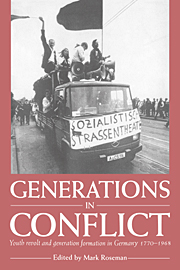Book contents
- Frontmatter
- Contents
- Contributors
- Acknowledgements
- List of abbreviations
- 1 Introduction: generation conflict and German history 1770–1968
- 2 The ideal of youth in late eighteenth-century Germany
- 3 Young Germans and Young Germany: some remarks on the history of German youth in the late eighteenth and in the first half of the nineteenth century
- 4 The battle for the young: mobilising young people in Wilhelmine Germany
- 5 Jewish politics and generational change in Wilhelmine Germany
- 6 The ‘front generation’ and the politics of Weimar Germany
- 7 The New Woman and generation conflict: perceptions of young women's sexual mores in the Weimar Republic
- 8 Generations of German historians: patronage, censorship and the containment of generation conflict 1918–1945
- 9 Gender, generation and politics: young Protestant women in the final years of the Weimar Republic
- 10 The Hitler Youth generation and its role in the two post-war German states
- 11 The BDM generation: a female generation in transition from dictatorship to democracy
- 12 A generation twice betrayed: youth policy in the transition from the Third Reich to the Soviet Zone of Occupation (1945–1946)
- 13 The generation conflict that never was: young labour in the Ruhr mining industry 1945–1957
- 14 The German Kriegskinder: origins and impact of the generation of 1968
- Index
7 - The New Woman and generation conflict: perceptions of young women's sexual mores in the Weimar Republic
Published online by Cambridge University Press: 19 October 2009
- Frontmatter
- Contents
- Contributors
- Acknowledgements
- List of abbreviations
- 1 Introduction: generation conflict and German history 1770–1968
- 2 The ideal of youth in late eighteenth-century Germany
- 3 Young Germans and Young Germany: some remarks on the history of German youth in the late eighteenth and in the first half of the nineteenth century
- 4 The battle for the young: mobilising young people in Wilhelmine Germany
- 5 Jewish politics and generational change in Wilhelmine Germany
- 6 The ‘front generation’ and the politics of Weimar Germany
- 7 The New Woman and generation conflict: perceptions of young women's sexual mores in the Weimar Republic
- 8 Generations of German historians: patronage, censorship and the containment of generation conflict 1918–1945
- 9 Gender, generation and politics: young Protestant women in the final years of the Weimar Republic
- 10 The Hitler Youth generation and its role in the two post-war German states
- 11 The BDM generation: a female generation in transition from dictatorship to democracy
- 12 A generation twice betrayed: youth policy in the transition from the Third Reich to the Soviet Zone of Occupation (1945–1946)
- 13 The generation conflict that never was: young labour in the Ruhr mining industry 1945–1957
- 14 The German Kriegskinder: origins and impact of the generation of 1968
- Index
Summary
For contemporaries, the emergence of the New Woman was one of the most striking and challenging features of Weimar society. Contemporary discussion was set alight by the provocative behaviour and dress of a new generation of young women who seemed determined to break with established norms. For some observers, the New Woman's defining characteristic was the abandonment of motherhood. Many conservatives argued that because of the New Woman's fecklessness and irresponsibility the family was in crisis, moral depravity on the increase and society suffering from the effects of husbands and wives both going out to work. Others were conscious rather of a new female style. For them the quintessential New Woman was a pleasure-seeking glamour girl, dressed in short skirt or even in trousers, hair worn bobbed in a Bubikopf, wearing make up and smoking cigarettes.
Historians have been divided on how to treat the phenomenon. For a while, there was a tendency to argue that there never really had been a New Woman. The conservatives' dismay was seen as exaggerated propaganda, stoking up public fears in order to defend reactionary viewpoints. Similarly, the image of the glamour girl was dismissed as media hype. Fashion changes there may have been, but they applied only to a small section of the urban population and certainly had little to do with a wider emancipation or change of values. Finally, it was argued, the suggestion that there was a new emancipated generation of young women ignored the persistent high levels of gender inequality; old assumptions and gender roles remained predominant. More recently, however, historians of Weimar have acknowledged the very real changes to women's social position.
- Type
- Chapter
- Information
- Generations in ConflictYouth Revolt and Generation Formation in Germany 1770–1968, pp. 137 - 163Publisher: Cambridge University PressPrint publication year: 1995
- 5
- Cited by



